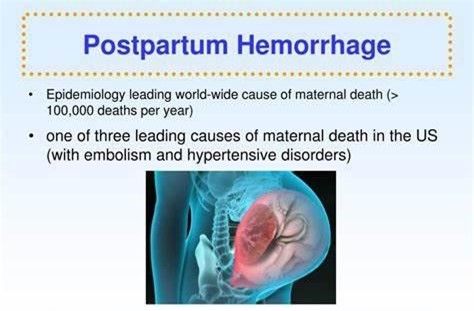Adllent, 1 day postpartum, is being monitored after a postpartum hemorrhage. Which of the following should the nurse report to the obstetrician?
Urine output of 200 mL for the past 8 hours.
Weight decrease of 2 pounds since delivery.
Pulse rate of 65 beats per minute.
Drop in hematocrit of 6% since admission.
The Correct Answer is D
Choice a) Urine output of 200 mL for the past 8 hours is incorrect because this is a normal finding for a postpartum woman. The average urine output for a healthy adult is about 800 to 2000 mL per day, which means about 100 to 250 mL per hour. Therefore, a urine output of 200 mL for the past 8 hours is within the normal range and does not indicate any complications.
Choice b) Weight decrease of 2 pounds since delivery is incorrect because this is also a normal finding for a postpartum woman. The weight loss is due to the expulsion of the placenta, amniotic fluid, and blood during delivery. A postpartum woman can expect to lose about 10 to 12 pounds immediately after giving birth, and another 5 pounds in the following weeks due to fluid loss. Therefore, a weight decrease of 2 pounds since delivery is not a cause for concern and does not need to be reported to the obstetrician.
Choice c) Pulse rate of 65 beats per minute is incorrect because this is also a normal finding for a postpartum woman. The normal resting pulse rate for an adult ranges from 60 to 100 beats per minute, and it may decrease slightly after delivery due to blood loss and reduced cardiac output. Therefore, a pulse rate of 65 beats per minute is not indicative of any problems and does not require any intervention.
Choice d) Drop in hematocrit of 6% since admission is correct because this is an abnormal finding for a postpartum woman and suggests that she has developed anemia due to excessive blood loss. Hematocrit is the percentage of red blood cells in the blood, and it reflects the oxygen-carrying capacity of the blood. The normal hematocrit range for an adult female is 37% to 47%, and it may decrease slightly after delivery due to hemodilution. However, a drop in hematocrit of more than 10% from the baseline or below 30% indicates severe anemia and requires immediate treatment. Therefore, a drop in hematocrit of 6% since admission is a significant change that should be reported to the obstetrician as soon as possible.

Nursing Test Bank
Naxlex Comprehensive Predictor Exams
Related Questions
Correct Answer is B
Explanation
Choice A) Increased urinary output: This is not a sign of sepsis in newborns. In fact, sepsis can cause reduced urinary output due to poor blood flow to the kidneys and dehydration.
Choice B) Hypothermia: This is a sign of sepsis in newborns. Sepsis can cause changes in temperature, often fever, but sometimes low temperature. Hypothermia can indicate a severe infection that affects the body's ability to regulate its temperature.
Choice C) Wakefulness: This is not a sign of sepsis in newborns. Sepsis can cause reduced activity and lethargy due to inflammation and organ dysfunction.
Choice D) Interest in feeding: This is not a sign of sepsis in newborns. Sepsis can cause reduced sucking and difficulty feeding due to poor appetite, nausea, vomiting, and abdominal distension.
Correct Answer is B
Explanation
Choice a) Document the event in the nurses' notes is incorrect because this is not a priority action for a neonate who is showing signs of hypoglycemia. Hypoglycemia is a condition where the blood glucose level is lower than normal, which can cause neurological and metabolic problems in newborns. Neonates of diabetic mothers are at higher risk of developing hypoglycemia due to increased insulin production and decreased glycogen stores.
Documenting the event in the nurses' notes is an important step, but it should be done after assessing and treating the neonate's condition.
Choice b) Test for blood glucose level is correct because this is the most important action for a neonate who is exhibiting symptoms of hypoglycemia. The nurse should use a heel stick or a cord blood sample to measure the blood glucose level of the neonate as soon as possible, as hypoglycemia can lead to serious complications such as seizures, coma, brain damage, or death if left untreated. The normal blood glucose range for a full-term neonate is 40 to 60 mg/dL in the first hour of life, and 50 to 90 mg/dL thereafter. A blood glucose level below 40 mg/dL indicates hypoglycemia and requires immediate intervention.
Choice c) Notify the clinician stat is incorrect because this is not the most urgent action for a neonate who is suffering from hypoglycemia. The nurse should notify the clinician after confirming the diagnosis of hypoglycemia and initiating treatment, such as feeding or administering intravenous glucose. The clinician may order further tests or treatments depending on the severity and cause of the hypoglycemia, but the nurse should not delay the initial management of the neonate's condition.
Choice d) Start an intravenous line with D5W is incorrect because this is not the first-line treatment for a neonate who has hypoglycemia. D5W stands for dextrose 5% in water, which is a solution that contains glucose and water. It can be used to treat hypoglycemia by providing a source of energy and fluid to the neonate. However, before starting an intravenous line with D5W, the nurse should first attempt to feed the neonate with breast milk or formula, as this can also raise the blood glucose level and provide other nutrients and antibodies. If feeding is unsuccessful or contraindicated, then the nurse should start an intravenous line with D5W as ordered by the clinician.

Whether you are a student looking to ace your exams or a practicing nurse seeking to enhance your expertise , our nursing education contents will empower you with the confidence and competence to make a difference in the lives of patients and become a respected leader in the healthcare field.
Visit Naxlex, invest in your future and unlock endless possibilities with our unparalleled nursing education contents today
Report Wrong Answer on the Current Question
Do you disagree with the answer? If yes, what is your expected answer? Explain.
Kindly be descriptive with the issue you are facing.
